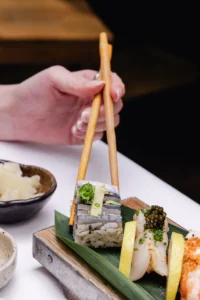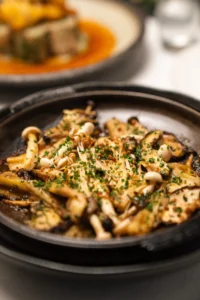Wabi Sabi Food Aesthetics on a Plate
Wabi sabi food aesthetics shape Japanese cuisine through a deep respect for form, feeling, and the beauty of imperfection. This concept finds beauty in imperfection, simplicity, and the passing of time. When applied to food, it creates dishes that feel honest, humble, and deeply human. In a world chasing perfection, wabi sabi invites us to slow down and savour what is natural and real.
What Is Wabi-Sabi?
 Wabi sabi is more than just a design trend. It is a way of life rooted in Zen Buddhism. It values things that are raw, aged, or slightly flawed. Cracks in pottery, uneven shapes, and faded colours are all welcome. They tell a story. They reveal time, care, and character.
Wabi sabi is more than just a design trend. It is a way of life rooted in Zen Buddhism. It values things that are raw, aged, or slightly flawed. Cracks in pottery, uneven shapes, and faded colours are all welcome. They tell a story. They reveal time, care, and character.
In food, this mindset moves away from perfection. Instead of polished dishes and identical cuts, wabi sabi celebrates the handmade and the unique. A slightly burnt edge, a crooked slice, or a rustic plate adds charm. These are not mistakes – they are marks of truth.
Minimalism in Japanese Cuisine
Less Is More
Minimalism plays a huge role in Japanese cooking. Dishes are often simple, with only a few ingredients. Yet each one is chosen with care and prepared with respect. The aim is not to impress with excess, but to highlight the natural taste and shape of the food.
Take sashimi, for example. It offers clean slices of raw fish on a plain plate. No rich sauces or heavy garnishes. Instead, the focus is on freshness, colour, and cut. This pure style leaves space for the diner to notice every detail.
Calm and Clean Presentation
Minimalism also affects how food looks. Chefs often use neutral tones and empty space. Plates might seem bare at first glance. But this emptiness draws the eye to what matters. It also gives the mind a moment to pause.
This quiet elegance creates a sense of calm. It lets the eater connect more deeply with the meal. Every piece has a place. Every item has a reason to be there.
Transience and the Seasons
The Beauty of the Moment
Japanese cuisine changes with the seasons. Chefs use ingredients at their peak and adjust their menu throughout the year. This focus on seasonality ties closely to wabi sabi, which sees beauty in things that do not last.
Spring brings tender greens and cherry blossoms; meanwhile, autumn offers earthy mushrooms and chestnuts. Naturally, each season has its own colours, textures, and flavours. However, each one eventually passes. Still, this passing is not sad. Instead, it reminds us to enjoy what we have now.
Nature on the Plate
Seasonal ingredients are not just about taste. They shape how a dish looks and feels. For instance, a summer dish might include a cool blue plate or an ice bed. A winter meal might arrive in a warm clay bowl.
Even garnishes, for instance, reflect nature. A maple leaf, a twig of pine, or a petal, similarly, gives a sense of place and time. However, they are not just decorations. Instead, they act as silent guides, pointing us to the world outside.
The Art of Imperfect Beauty: Wabi Sabi Food Aesthetics
The Hand of the Maker
In wabi sabi cooking, you can see the maker’s hand. Unlike factory-made food, each dish has its own shape and look. One rice ball might be rounder than the next. A piece of tempura might curl a little. These quirks add personality.
Handmade ceramics often hold these meals. Their uneven glazes, soft dents, and organic shapes match the food they carry. Together, they form a quiet harmony between plate and plateful.
Depth in Simplicity
 Though the food may look plain, it holds great depth. A clear broth, for instance, might take hours to prepare. Its clarity hides the skill behind it. This hidden work is also part of wabi sabi. It rewards those who look closely and pay attention.
Though the food may look plain, it holds great depth. A clear broth, for instance, might take hours to prepare. Its clarity hides the skill behind it. This hidden work is also part of wabi sabi. It rewards those who look closely and pay attention.
Even the silence around the meal matters. The act of eating becomes a quiet ritual. There is no need for loud praise. Just presence.
Embracing Wabi Sabi in Modern Dining
A Shift from Perfection
Today, more people crave authenticity. Mass-produced meals no longer satisfy like they used to. Diners want food with a story. They want to feel a human touch. As a result, wabi sabi has found new fans across the world.
This trend also pushes back against social media’s polished plates. It invites a different kind of beauty. A chipped teacup, a lopsided dumpling, or a faded tablecloth becomes a source of joy.
Slow Food and Mindful Meals
Wabi sabi pairs well with the slow food movement. Both value time, care, and connection. Eating becomes more than just fuel. It becomes an act of gratitude.
Restaurants that follow this style often use natural light, simple décor, and quiet music. Additionally, menus may change often to match what is fresh and local. As a result, every visit feels special and fleeting.
Final Thoughts: Wabi Sabi Food Aesthetics
Wabi sabi reminds us that food is not just about looks or trends. It is about life itself – with all its changes, flaws, and moments of grace. By embracing this idea, Japanese cuisine offers something rare: a taste of truth.
In a world filled with pressure to be perfect, wabi sabi offers a peaceful escape. It tells us to pause, breathe, and enjoy things as they are. Not flawless. Not forever. But full of beauty all the same.



